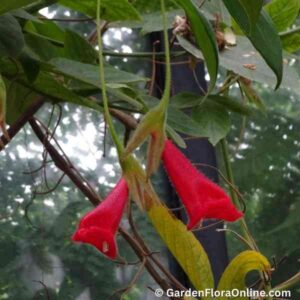A woody climber, up to 3 m long. Leaves opposite, 2-foliate, often with a tendril in-between the leaflets; leaflets oblong-ovate, 10-20 × 3-9 cm, coriaceous. Flowers 6.5-9 cm long and 3-5 cm in diam., purple mauve.
Cultivation: Grows well in open ground in tropical and subtropical humid regions. Prefers full sun or partial shade and well-drained soil, avoiding water-logging. Thrives in soil rich in organic matter with abundant water during the growing season. Pruning to maintain a compact form or shape it into a bush should be done after flowering.
Etymology: The genus name “Mansoa” honours the Brazilian botanist Antônio Luiz Patrício da Silva Manso (1788-1848), recognized for his contributions to botany. The specific epithet “alliacea” is derived from the Latin allium, meaning garlic, referencing the plant’s garlic-like aroma, particularly noticeable when its leaves are crushed. This characteristic has earned Mansoa alliacea its common name, “garlic vine.“








